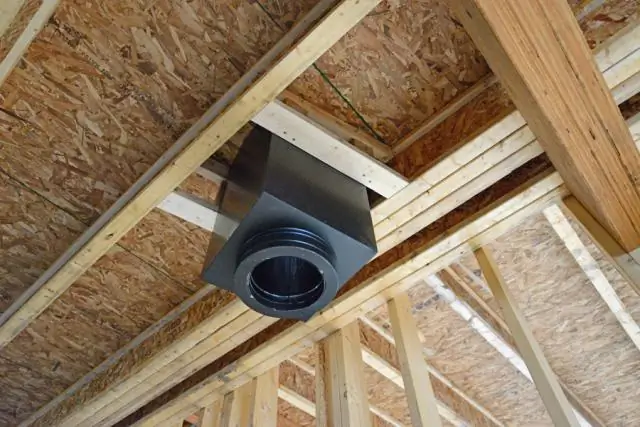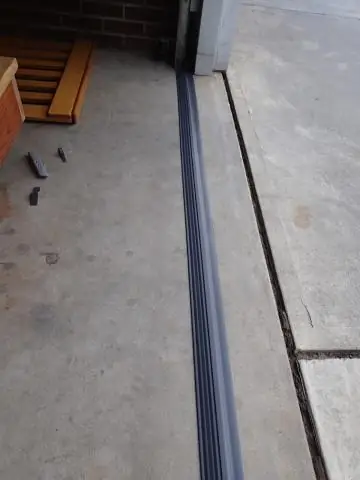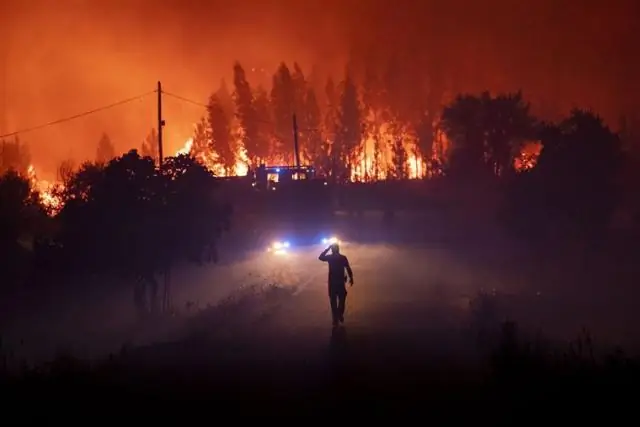
Table of contents:
- How to insulate a chimney pipe with your own hands: the choice of insulation, preparation and implementation of thermal insulation work
- Why do you need to insulate the chimney
- Heaters for chimney insulation
- Steel insulated chimney construction
- Calculation of materials and design parameters
- Preparatory work before installing thermal insulation
- Do-it-yourself chimney insulation
- The main mistakes in insulation
- Author Bailey Albertson [email protected].
- Public 2023-12-17 12:53.
- Last modified 2025-06-01 07:32.
How to insulate a chimney pipe with your own hands: the choice of insulation, preparation and implementation of thermal insulation work

The chimney is the central element of the chimney system in any private house where there is heating equipment that runs on solid or liquid fuel. For its efficient operation, not only compliance with the installation technology is required, but also the device of a full-fledged heat-insulating layer, which will be located outside the chimney.
Content
-
1 Why you need to insulate the chimney
1.1 Advantages of the insulated chimney
-
2 Heaters for thermal insulation of the chimney
-
2.1 What insulation is better to choose
2.1.1 Video: test for flammability of basalt wool
-
- 3 Construction of a steel insulated chimney
-
4 Calculation of materials and design parameters
4.1 Required tools and consumables
- 5 Preparatory work before installing thermal insulation
-
6 Do-it-yourself chimney insulation
-
6.1 Technology of insulation of brick chimneys
6.1.1 Video: cladding and insulation of a brick chimney
-
6.2 Technology of steel chimney insulation
6.2.1 Video: Insulating a steel chimney
- 6.3 Thermal insulation of square and rectangular chimneys
-
- 7 The main mistakes in insulation
Why do you need to insulate the chimney
During operation, a large amount of combustion products and hot air are transported through the smoke channel. All this reduces the durability of the chimney by accelerating the processes of corrosion and oxidation of the inner walls of the exhaust duct.
Among the most common problems that lead to damage to the chimney are:
-
presence of moisture - increased pressure and constant humidity are observed in the chimney. Due to the temperature difference inside and outside the chimney, moisture partially condenses on the channel walls, which ultimately adversely affects the operational state of the metal;

Condensation in the chimney In the absence of thermal insulation, a large amount of condensate accumulates in the chimney
- chemical environment - when solid or liquid fuels are burned, a large amount of corrosive substances are formed that are dangerous to human health. With the correct operation of the chimney, all formed substances are removed outside by natural draft. With a decrease in the level of draft or at a time when the chimney is not functioning, substances accumulate on the walls of the chimney, which leads to a slow but progressive destruction of the chimney.
Thermal insulation of the chimney with modern thermal insulation materials reduces the risk of damage and reduces the rate of corrosion processes. For example, the insulation of steel chimneys extends the service life of the product by 2 or more times.
Advantages of an insulated chimney
Timely thermal insulation of the chimney reduces the risk of exposure to factors leading to the formation of damage in metal, brick or ceramics. With the correct thickness of the insulation, the problem with condensate is almost completely solved - the dew point shifts to the section of the pipe located above the roof level. This significantly increases the resource of the smoke channel and the service life of the smoke exhaust system as a whole.

Chimney insulation increases its service life several times
Other advantages of an insulated chimney include:
- Decrease in the level of deposits - thermal insulation materials help to reduce the temperature difference between the combustion products and the surface of the chimney. This reduces the amount of substances deposited on the inner surface of the chimney.
- Energy saving - in the process of operation, the insulated chimney takes less energy from the combustion of fuel. This allows you to reduce fuel consumption and energy spent on maintaining a constant temperature in the combustion chamber.
- Strength and stability - the thermal insulation installed around the chimney acts as a frame and increases the strength and stability of the structure. This is especially noticeable when installing thin-walled metal chimneys.
Modern heaters increase the frost resistance of the smoke exhaust system. If the insulation technology is observed, it is possible to reduce or completely eliminate the effect of high temperature in the section of the pipe outlet through the roof.
Heaters for chimney insulation
For the insulation of the chimney, materials are used that provide a high degree of insulation, coupled with low thermal conductivity. This eliminates the risk of cold bridges, icing and condensation.
Among the most effective and popular materials for insulation are the following:
-
plaster - used for insulation of brick and stone chimneys. The plaster mortar is applied to a previously prepared reinforced surface. In terms of the ratio of labor costs and quality, this method is the least justified;

Chimney insulation with heat-resistant plaster Insulating the chimney with heat-resistant plaster requires unreasonably large labor costs
-
broken brick - used for thermal insulation of brick and steel structures. The material is poured into a casing that is fixed around the chimney. The minimum distance from the chimney is 60 mm. Sometimes slag is used instead of broken brick;

Chimney insulation with slag The sifted slag tightly fills the installation gap and provides a high degree of thermal insulation of the chimney
- basalt wool is a modern heat-insulating material produced in the form of mats or cylinders with different internal sections. The material is wrapped around the chimney and fixed with steel crimp clamps. In terms of value for money, this method is the most effective.
In fact, all the methods described above have some similarities - insulation is applied or fixed on the outer surface of the chimney. After that, the insulating material is protected by a steel casing.
In order to save money, the outer steel pipe can be replaced with wooden or slag concrete slabs. For example, a rectangular frame can be fixed around the chimney using the wooden shields at hand, and the space between the pipe and the shields can be filled with any heat-insulating material.
What insulation is better to choose
The first thing to remember when choosing a material for insulating a chimney is that thermal insulation must be made of non-combustible components. In operation, the flue heater will be heated to 100-150 of the C and O at the site through the tube overlapping the temperature can be even higher.
If the installation of the insulation will be performed by one person, then it is better to choose the lightest and most solid material. Otherwise, in the course of warming, problems will certainly arise, which ultimately will affect the quality of the work carried out.
For self-insulation of the chimney, it is better to use basalt thermal insulation. The shape and thickness of the product is selected taking into account the existing chimney design.

The basalt cylinder can be matched exactly to the chimney pipe size
The advantages of basalt wool heaters include:
- high thermal insulation qualities;
- good vapor permeability;
- resistance to chemicals;
- immunity to the formation of fungus and mold;
- high heat resistance when heated above 100 for C;
- environmental friendliness and safety.
Before using the finished thermal insulation from the manufacturer, you should carefully study the technology of its installation. As a rule, high-quality products are completed with a paper insert or instructions, which describe in detail how they are cut and installed.
Video: test for flammability of basalt wool
Steel insulated chimney construction
The insulated chimney is a pipe-in-pipe structure similar to a sandwich pipe, which is also used for the construction of flue ducts. Usually, a wooden box lined with asbestos boards or a large diameter steel pipe acts as an outer pipe.

Any insulated chimney consists of a smoke exhaust channel, an outer shell and a layer of insulation between them
A non-combustible heat-insulating material is placed between the outer shell and the chimney, mechanically fixed or glued to heat-resistant glue or sealant. The inside of the insulated chimney is nothing more than a chimney.
The layer of material used as insulation acts as a thermal insulation barrier. On the one hand, it prevents heating elements directly in contact with the chimney. On the other hand, cold air does not cool the chimney and thus does not create a sharp difference between the temperature of the outgoing combustion products and the inner surface of the chimney.
Calculation of materials and design parameters
Before purchasing insulation and materials necessary for assembling the frame around the chimney structure, they will need to be calculated. This will save money, especially if specialized expensive products are used for insulation.
Before making calculations, you will need to measure:
- outer section of the chimney;
- length and width (diameter) of the chimney;
- the height of the pipe from the inlet.
The data obtained allow us to calculate the required amount of thermal insulation material and additional accessories. As an example, we calculate the materials for insulating a steel chimney with a section of 200 mm and a height of 5 m.

For thermal insulation of round chimneys, ready-made cylindrical fragments of insulation are produced
When using a basalt "shell", products with a total length of 5 running meters with an inner cylinder diameter of 210 mm will be required. The density of the insulation is 120-150 kg / m 3. The thickness of the heat insulator is selected taking into account the temperature regime in the region. For operation in the conditions of the Russian winter, cylinders with a thickness of 70-100 mm are sufficient. As an outer pipe, you will need a product made of galvanized steel with a section of 280-310 mm with a total length of 5 m.

It is convenient to use basalt wool in slabs to insulate square chimneys
To insulate chimneys with a square or rectangular cross-section, you need to know their dimensions. For example, a square chimney with a side of 0.3 m will require (0.3 * 5) * 4 = 6 m 2 of insulation. The length of the chimney is still considered to be 5 m.
If you buy a high-quality insulation, then usually one package contains a roll with a total area of 5 m 2. This means that for our example, two packs of basalt wool in rolls are required. Roll parameters - 5000x1000x50 mm. A 50 × 50 mm bar can be used to assemble the frame around a square chimney. An asbestos board 3000x1500x12 is better suited for external cladding.
Required tools and supplies
In addition to insulation, additional consumables are needed for thermal insulation work. For the assembly of the wooden frame and its cladding, galvanized self-tapping screws with a length of 30 mm are used. To fix the heat insulator, a refractory sealant is used - Penosil High Temp, PENOSIL Premium 1500 or MAKROFLEX HA147.

Heat-resistant sealant is used to fix the insulation to the chimney surface
To insulate chimneys made of steel or ceramics, you will need:
- scissors for metal;
- construction knife;
- screwdriver;
- angle grinder;
- set of screwdrivers;
- protective glasses and gloves;
- tape measure and pencil.
For plastering the chimney, it is necessary to prepare a container for plaster, a plastering trowel, a wooden rectangular trowel, a triangular trowel, a rule and a long-bristled paint brush.
Preparatory work before installing thermal insulation
Before carrying out thermal insulation work, you should check the reliability and strength of the foundation, which was erected under the furnace or other heating equipment.
If there is no foundation, then before insulating the chimney, it will be necessary to assemble the supporting structure under the outer casing. This can be either a support bracket, which can be purchased at a store, or a welded frame made from a steel corner. Usually, ready-made support brackets are used for steel chimneys, and in the case of a brick chimney, the foundation structure is already designed for current loads.
After that, you should carefully inspect the place of the chimney outlet through the ceilings and the roof. The ceiling outlet must be protected with a steel box. The minimum distance from the chimney to the duct walls is at least 20 cm. When exiting through the roof, the chimney should not come into contact with the roof structures. To do this, provide appropriate spacers or a special hood that is mounted outside the building.

The chimney outlet through the ceiling must be protected by a metal box
Do-it-yourself chimney insulation
Before proceeding with insulation, the outer surface of the chimney should be cleaned of dust and dirt. For this, a regular brush with a hard bristle and a broom are used. When cleaning a brick chimney, remove excess dust and loose cement. This can be done with a paintbrush and water.
Brick chimney insulation technology
Insulation of a brick chimney can be done using different materials. The most time consuming and ineffective method is plastering, but many still use it, since this does not require large expenses. On average, after work, heat losses are reduced by 20-25%.
The sequence of actions for plastering is as follows:
-
In a clean container with a rounded bottom, a mortar based on M500 cement, dry lime and fine slag is mixed. Before kneading, the slag is sieved. The first portion of the solution should be very thick.

Components for mixing plaster To prepare the plaster, it is necessary to knead a solution of cement, lime and slag
-
The mortar is carefully applied to the joints between the bricks. At this stage, you need to fill in all the voids. It is advisable to do this before the steel mesh is fixed to the pipe surface.

Chimney insulation with plaster mixture Brick chimneys are sometimes insulated with heat-resistant plaster, although this is considered the least effective method.
- A reinforcing steel mesh is fixed on the surface of the chimney. Then you can start carrying the plaster mixture. The thickness of the first layer is no more than 3-4 cm. After application, the plaster layer should set and dry slightly.
- A second plaster layer is applied with a thickness of up to 5-7 cm. If the declared thickness cannot be applied, then a layer of 3-4 cm is applied. Next, you will need to wait for it to set and repeat the work until the plaster coating of the required thickness is obtained.
-
The finishing layer is applied. The surface is carefully leveled and rubbed with a scraper. Cracks may form when dry, which must be covered before finishing.

Finishing brick chimney After finishing with a finishing coating, the chimney will become not only warm, but also much more beautiful
After drying, the plaster is bleached with a solution of lime and chalk. If necessary, it is applied in 2-3 layers. Instead of a cement-slag mixture, you can use heat-resistant plaster with fire resistance up to 600 ° C.
Video: sheathing and insulation of a brick chimney
Steel chimney insulation technology
The technology described below can be used to insulate any round chimney, but is most often used for thermal insulation of steel structures. The sequence of work will depend on the type of outer pipe. We recommend using a telescopic tube from the manufacturer.
Thermal insulation work is performed in the following order:
- Basalt insulation is fixed on the surface of the chimney near the inlet pipe. For this, it is wrapped around the chimney until the desired thickness is formed. After that, the heat insulator is pulled together with a crimp clamp.
-
A steel pipe of a larger diameter is put on top of the insulated area. At the bottom, the pipe is fixed with a chimney clamp. After this, the work is repeated until the entire structure is insulated. The joints of the pipes are treated with a heat-resistant sealant.

Insulation of a steel chimney with mineral wool in rolls Insulation of the steel chimney can be done with roll material or use ready-made cylindrical blanks of the required diameter
- If a basalt cylinder is used, it can be mounted after the casing has been installed. For this, the inner part, as well as the connecting "spike" and "groove" of the cylinder, are treated with a heat-resistant sealant. After that, the cylinder is lowered into the casing.
In the process of work, you should carefully monitor the docking of the elements. The joint between the top and bottom pipes must have no visible gap. When using pipes without a weld seam, the joint is also treated with a sealant.
Video: thermal insulation of a steel chimney
Insulation of chimneys of square and rectangular shape
This technology is most often used to insulate brick chimneys. But if necessary, this method can be used to insulate the chimney from one or more asbestos pipes.
Warming is performed in the following sequence:
-
Along the perimeter of the chimney, a frame is assembled from a wooden bar 50 × 50 mm or a metal corner. When assembling, it should be borne in mind that there must be a distance of at least 100 mm between the walls of the frame and the chimney. For assembly, galvanized nails and self-tapping screws 30-50 mm long are used.

Assembling the frame around the chimney The frame around the chimney for laying the insulation is assembled from wooden bars or from a metal profile
- The frame is mounted on the chimney structure. As a result, a space is formed between the pipe and the walls of the frame, which is filled with basalt wool. The insulation, as in the previous case, is fixed to a heat-resistant sealant.
- After the installation of the insulation, the front part of the frame is sheathed with an asbestos slab 10-12 mm thick. After sheathing, the work is repeated. If desired, the sheathing of the entire chimney can be done last, immediately after filling the voids with insulation.
After installation, the joint between the asbestos slabs at the corners of the frame is filled with heat-resistant plaster. From the side of the chimney outlet, the surface is also rubbed with heat-resistant plaster.
The main mistakes in insulation
After performing the thermal insulation work, a test furnace of the furnace or boiler should be carried out. Maximum power no more than 60% of the nominal. To diagnose and check the quality of insulation, you will need to purchase or rent a handheld thermal imager. In the process of diagnostics, you should find out how tight the outer casing of the insulated chimney is. If everything is in order, then neither the walls of the structure, nor the connecting seams will allow heat to pass through. This will be clearly visible on the equipment screen.
Loss of tightness is the most common problem that leads to burnout of the chimney and overheating of the insulation. If such a problem is present, then you will need to remove the outer pipe or casing and reinstall it in compliance with the technology.

Burning out of the insulated chimney may occur due to loss of tightness or due to incorrectly selected thickness of the heat insulator
If, after insulating the chimney, condensate still continues to accumulate, then most likely the thickness of the thermal insulation was incorrectly selected. The minimum thickness of the insulation should not be less than 4 cm. To insulate steel and asbestos pipes with a height of more than 6 m, it is recommended to use insulation 10 cm thick. When insulating brick chimneys, it is better to use insulating plates with a total thickness of 8 cm.
Chimney insulation is a mandatory work that must be performed immediately after the construction of the flue gas system and ventilation. It is optimal if, already at the stage of arranging the chimney, modern thermal insulation materials or finished products with a thermal insulation layer are used. This will make it possible to assemble a chimney that will serve the entire declared period without forced downtime for repair periods.
Recommended:
How And How To Insulate The Garage From The Inside With Your Own Hands - Instructions With Photos And Videos

Self-insulation of the garage. Insulation selection, material calculation and process description
How To Make A Gate From A Profile Pipe With Your Own Hands - Step-by-step Instructions With Photos And Videos

The profile pipe is in demand for solving various tasks. How, using available material, to make and decorate with your own hands a gate for a garage or summer cottage?
How To Make A Chimney From A Steel Pipe With Your Own Hands: Device, Installation Of A Sandwich Structure, Instructions With Photos And Videos

What is a steel pipe chimney, where is it used, its advantages, disadvantages and its manufacture by hand
How To Make A Bench From A Profile Pipe With Your Own Hands - Step-by-step Instructions For Creating A Metal Bench With Photos, Videos And Drawings

The profile pipe is used for various purposes. How to make and decorate a bench or a bench for a summer residence or a private house from metal with your own hands?
How To Make A Lamp With Your Own Hands From Scrap Materials: Photo Ideas, Step-by-step Instructions

How to make lamps with your own hands. Photo-gallery of ideas. Step by step instructions. Video
